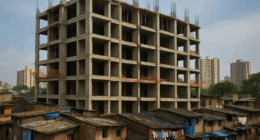· 2023 net absorption levels to match previous year, surpassing 2017-2019 average
· 2024 office net absorption to increase by 20-22% year-on-year, reaching 45-47 mn sq ft
· 2023 office supply expected at 47-49 mn sq ft
· 2024 supply projected to rise by 22-23% year-on-year, reaching 58-60 mn sq ft
The office sector has seen sustained growth in demand in 2023 despite the global sluggishness and is poised to achieve next level of growth in 2024 according to JLL recent report titled ‘2023: A Year in Review’.
Net absorption from Jan-Sep 2023 was at 26 mn sq ft which is 68% of 2022 full year number. In 2023, net absorption in office market is expected to be at par with 2022 to close at 37-39 mn sq ft. With leasing activity expected to further pick up pace in the last quarter of 2023, the year is expected to surpass the 2017-2019 average. The office markets’ performance is a testament to the strong fundamentals of demand and the absence of any lasting effects of the global headwinds. In 2024, Net absorption is further expected to increase by 20-22% to touch 45-47 mn sq ft.
Despite a 23.9% year-on-year decrease in supply during the first nine months of 2023, it is anticipated to strengthen and reach approximately 47-49 mn sq ft by the end of the year. In line with the net absorption, the supply in 2023 will be higher than the 2017-2019 pre-pandemic average. In 2024, it is expected to increase by 22-23% y-o-y to reach 58-60 mn sq ft. It is seen that there is a trend of flight to quality creating demand polarization towards buildings owned by institutional owners and established developers.
“The office space in India’s top seven markets is expected to increase to over 800 mn sq ft by the fourth quarter of 2023, up from the current 792.8 mn sq ft as of September 2023. ESG continued to remain a decisive action point for all stakeholders in 2023 as energy consumption, green and net zero commitments are driving corporate action. The increasing importance of sustainability is reflected in increase in green certified buildings in last few years. Green certified buildings share in Grade A office stock went up from 39% in 2020 to 53% in 2023 (as of September 2023),” said Rahul Arora, Head – Office Leasing Advisory and Retail Services, India, JLL.
India’s office market: performance-based resilience
| 9M 2023 net absorption | Estimated net absorption in 2023 | Forecasted net absorption in 2024 | 9M 2023 supply | Estimated supply in 2023 | Forecasted supply in 2024 |
| 26 mn sq ft(68% of 2022 full year number) | 37-39 mn sq ft | 45-47 mn sq ft | 29.9 mn sq ft | 47-49 mn sq ft | 58-60 mn sq ft |
Source: Real Estate Intelligence Service (REIS), JLL Research
Headline vacancy is expected to remain within 16-17% range by end of the year. With a strong supply pipeline of 55-60 mn sq ft lined up in 2024, vacancy is likely to remain sticky at 16-17% on the back of strong demand. Core markets, however, will continue to see single digit vacancy levels.
In 9M 2023, there is a slight decline in space take-up by tech firms but is still likely to account for the biggest share in gross leasing by the end of the year. Other segments such as manufacturing / industrial, BFSI and Consulting through setting up of Global Capability Centres (GCCs) strengthened their participation in leasing activity. Interestingly, GCCs have a 54% share in active office space requirements in top seven cities of India.
“In the year 2023, so far, India’s office market has stayed truly on course to see remarkable performance as net absorption is expected to exceed the three-year pre-pandemic average. We are likely to see net absorption of around 37-39 mn sq ft which is further expected to go up by 20-22% y-o-y to reach 45-47 mn sq ft in 2024. India’s innovation-led ecosystem, large talent pool and favorable policy initiatives will create a perfect growth tide for the office sector to flourish further in 2024. It is expected that more R&D Centres of Excellence will be set up in India at an accelerated pace. Therefore, GCCs will continue to be major drivers for increasing occupier demand in the future.” said, Dr Samantak Das, Chief Economist and Head of Research and REIS, India, JLL.
Flex continues to drive market activity.
With sustained demand for flexible and managed enterprise services, flex leasing in 2023 is expected to surpass the previous peak achieved in 2022 to close at ~145,000 seats. 9M 2023 is already ~80% of the total seats leased in the full year 2022. In 2024, around 150,000+ seats are expected to be leased by flex segment. There is sustained demand for flex as an essential element of occupier strategies which now assimilate both conventional and on-demand flex spaces for portfolio optimization and better employee experience.
Trends look forward to in 2024:
· GCCs key to increasing occupier demand; to help push absorption near previous peak levels. Segments like manufacturing, engineering R&D with Tech & BFSI are key drivers in this segment.
· With a strong supply pipeline of 58-60 mn sq ft lined up in 2024, headline vacancy is likely to remain sticky at 16-17%. Core markets, however, will continue to see single digit vacancy levels.
· Institutional, quality assets will remain first choice of occupiers with ‘flight to quality’ a running thread in space requirements.
· Sustainability will be key to real estate planning and portfolio strategy with occupiers demanding responsible real estate as part of their net zero targets.
· Office portfolios are likely to expand further as hybrid working evolves with a strong ‘office-first’ approach.
· Flex segment and dispersed Tier 1/Tier 2 strategy to drive space needs in 2024.
Also Read: How Infrastructure Projects are Creating New Real Estate Opportunities









